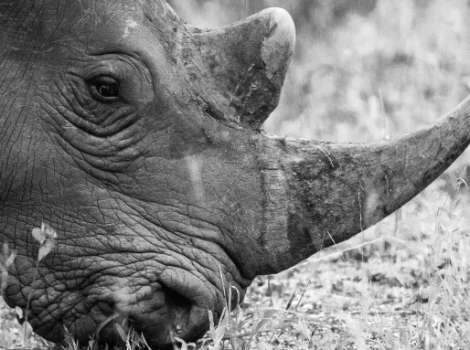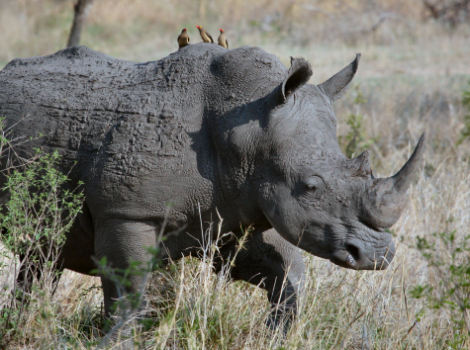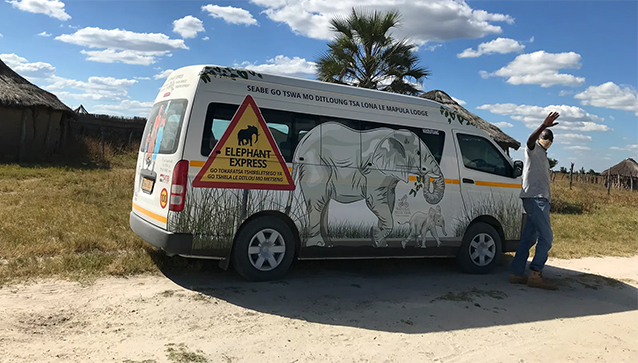
Botswana has as many elephants as it does people, leading to conflict where they both live in close quarters. Can a solution as simple as a bus help?
Four years ago, Nthoboga Samokwase’s father was travelling from the fields where he typically stayed during cropping season towards his home in the village 7km (4.3 miles) away when he had a confrontation with an elephant.
“We suspect that the elephant could have attacked him while he was unaware or he could not run because of his age,” says Samokwase. He was found trampled by the elephant and rushed to hospital but pronounced dead on arrival.
“It was a very sad day,” Samokwase recalls.
Until recently, Samokwase dreaded her sons would face a similar fate as her father as they walked each day almost 4km (2.5 miles) from their cattle post to their local primary school, crossing paths trodden by elephants along the way. But now, as she spends the afternoon in her traditional reed house after a day’s work growing sorghum and maize in the field, 28-year-old Samokwase rests assured that her two sons are being safely transported across the very same path. Samokwase lives in Gonutsuga, one of 13 villages in Botswana’s eastern Okavango panhandle, a region where elephant and human populations are almost equal in number – nearly 15,000 elephants live side-by-side with as many humans. For decades, the area has been a hotspot for human-elephant conflict. But two years ago, the Elephant Express bus was launched to ferry children and healthcare workers across elephant corridors, in a bid to limit the risks to humans.
The results have been promising. Community members and Ecoexist team members say the risks of being trampled by elephants has fallen, while medical care access and school attendance have increased. What’s more, fear and anxiety among locals have dropped.
“I no longer live in fear of losing my sons from a likely encounter with elephants,” says Samokwase.
Elephant town
Botswana is home to roughly 130,000 elephants, the largest population of any country. According to one report, the gigantic mammals were responsible for 67 human deaths between 2009 and 2019 – the highest number of victims caused by a wild animal in Botswana – and 26 injuries, the second highest after leopards. The rising human populations in the eastern panhandle have turned more wild lands into farmed fields while elephant numbers have tripled over the past two decades, leading fatal human-elephant conflict to become more frequent. The need for solutions to spread coexistence is urgent.
“The reality is an overpopulation of elephants concentrated in Botswana, in turn creating conflicts,” says Nyambe Nyambe, director of Kavango-Zambezi Transfrontier Conservation Area (KAZA), the world’s largest conservation area which spans Angola, Botswana, Namibia, Zambia and Zimbabwe.
The two-million-hectare (7,000-sq-mile) Okavango Delta sits in the north-west of the country. A World Heritage site due to its unique landscape of a vast inland river delta and expansive wetlands, it is a key crossing plain for Botswana’s elephant population, which migrates there to access water. Launched in 2020, the Elephant Express aims to serve villages like Samokwase’s which lie in the pathway between the delta and the elephant rangeland extending north to the Namibia border.
“Its chief aim is to “reduce conflict and promote coexistence”, says Othusitse Mosupi, field coordinator at the non-profit Ecoexist, which runs the vehicles.
The six villages covered by the initiative were chosen as they had witnessed the most human-elephant conflict, explains Mosupi. According to multiple local sources, approximately two people per year are crushed by elephants in this part of the delta. The Department of Wildlife and National Parks (DWNP) said that Ngamiland, the wider district in which the delta falls, recorded three human deaths and one injury by elephants in 2019 and four deaths and two injuries among humans in 2020.
Two minibuses now cover a stretch of 200km (124 miles) between the villages of Seronga and Guidgwa which lie at the V-shaped tip of the Okavango river. Public transport is a rarity here, leaving members of the community exposed to elephants. The many small settlements in between are also far from services such as schools and hospitals, meaning the buses have an added benefit.
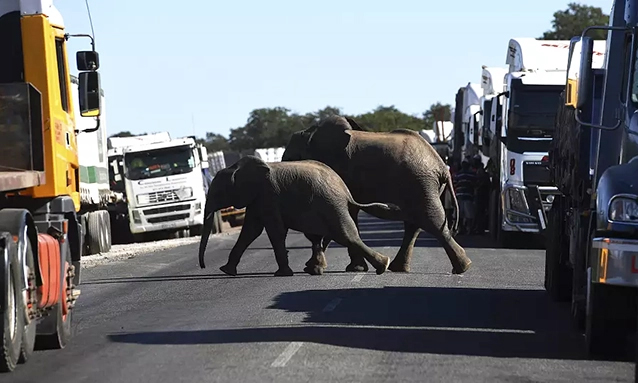
An uneasy co-existence
Fear of elephants has long dictated the daily behaviours of the thousands living in the villages dotting Okavango’s river banks. Villagers stay at home after sunset to avoid elephants roaming the region looking for food and water, finding traces of their feet and grazing on their lands and crops the following mornings.
Crop destruction is another source of tension between people and elephants: between 2009 and 2015, elephants carried out 1,518 raids on farmland in the panhandle, damaging crops which farmers and their families rely on to live.
These concerns previously extended to the need to get children to school.
“Parents were afraid that their children would have to walk to and from schools in the early mornings and evenings, as they were likely to encounter elephants,” says Anna Songhurst, a conservationist biologist and co-founder of Ecoexist.
“Even those who needed to seek services at clinics often didn’t, for fear of encountering elephants.”
Citing increased human-elephant conflict, in 2019 Botswana’s government lifted a five-year ban on elephant hunting to enable farmers to protect their livelihoods and lives from elephant attacks. Although the decision drew criticism from conservationists, it was welcomed by many in the region’s communities. Botshelo Sesinyi, general manager of the Okavango Community Trust, says that while elephants are a valuable source of income for Botswana’s tourism sector, to the poor farmers living in villages of the delta, they are “a menace threatening their livelihoods”.
Establishing human-elephant coexistence is important in many places across the world, and failure to create such harmony can be a threat even to thriving populations of elephants. Increased human-elephant conflict in Bangladesh, for example, has placed that country’s endangered elephant population in grave risk of extinction, with only a few hundred now remaining. In the Okavango Delta, an estimated 25 elephants are killed in conflicts every year. Ecoexist was set up in 2013 to foster harmony between humans and elephants in this hotspot region and help them to live side by side.
“Our mission is to support the lives and livelihoods of people who share space with elephants,” says Songhurst.
By bringing together farmers, scientists, village leaders, policy makers and business people, Ecoexist aims to create solutions to reduce human-elephant conflict. The Elephant Express is just one of these solutions. In setting it up, Ecoexist’s first task was to identify the elephants’ paths along certain corridors, as they move from dry land and into the Okavango Delta to access water. It did this by monitoring elephant movements, conducting ground surveys, interviewing villagers and collecting indigenous knowledge. It used this information to pin down certain locations where elephant corridors intersect with a gravel road that links all 13 villages together along the Okavango river. Ecoexist marked these spots in an effort to minimise pedestrian encounters with elephants.
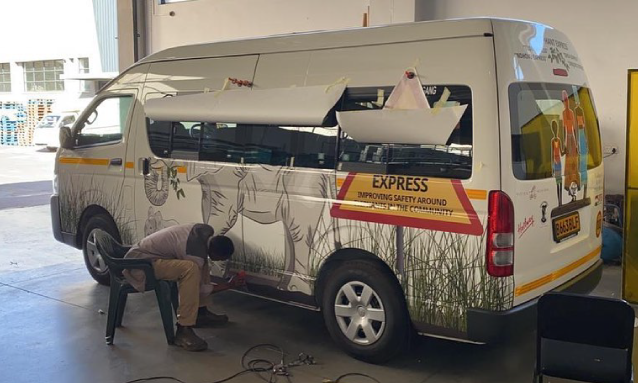
It then decided on the best bus routes. Ecoexist’s two minibuses now transport around 170 schoolchildren and 40 older students enrolled with Botswana Open University, as well as healthcare workers who are transported to clinics and patients, says Songhurst.
“Nurses and doctors are transported to places where health service is hard to access. During COVID-19 lockdowns, [the buses] transported nurses and doctors to people’s homesteads.”
Songhurst says there has been one incident of human trampling, in which the victim was neither a medic nor a student, since the buses began operations in 2020, down from at least one human death every year in that same area, she added. Official tallies for the deaths of “problematic elephants” in this period are unavailable for this specific region, the DWNP said.
According to Songhurst, in most cases where a person has been killed by an elephant in the eastern panhandle in the past thirteen years, one or more elephants have been shot in retaliation.
There are signs the buses have helped lower locals’ fear and anxiety of living with elephants, says Songhurst.
“Attendance rates at school have improved and teachers have also reported an improvement in performance as a result,” she says.
Parents say they feel much safer. Ikamogeleng Mojasagagwe, who lives on the outskirts of the village of Eretsha, says the buses are not only saving the lives of her two children, aged five and seven, but hers as well.
“It has really helped me as I am not at risk of crossing elephant corridors as I walk on foot to school and back,” she says.
“Previously, I had to get up early every morning to walk my kids across 6km (3.7 miles) to school and back, then again in the afternoon to pick them up from school, because they are young.”
Kerryn Carter, founder of the Zambia-based Elephant Connection, an NGO that promotes coexistence between elephants and humans, says offering sympathy and empathy to people impacted by elephants is an important part of reducing human-elephant conflict.
“The fact that [Ecoexist] is working on the ground alongside communities is very beneficial, as it makes people feel heard about how they are impacted by elephants,” she says.
“Communities generally feel ignored.”
Daily operations of the buses are co-managed between Ecoexist and the community trust, which will take over the operation of the buses, including finding funding, in three years time, adds Songhurst. Two tourism safari companies, Natural Selection and Unchartered Africa bought the original buses and covered annual costs of $20,000 (£16,600) for two years. KAZA has also promised financial support of €10,000 (£8,400, $10,100) towards the operations of the buses.
However, Sesinyi, of the Okavango Community Trust, says that operation costs usually surpass the available budget. Moyei Karundu, one of the two minibus drivers, tells me a lack of drivers means if one falls ill, the service is jeopardised. As well as the school run, he also transports children to their family cattle posts on Fridays and brings them back home on Sundays, to be ready for school the following day, he says.
On a Sunday morning, he brings the minibus decorated with paintings of elephants to a halt at a designated bus stop on the dirt road between Eretsha and Gonutsuga. As he waits for children to come running to the bus stop and board the vehicle with containers of fresh milk, sour milk and meat to take home from their cattle posts, he points to a dark green sign inscribed “Elephant Corridor”. An elephant trampled to death a 20-year-old young woman here three years back, he says.
But there are far more people who need assistance than the two buses can provide for with current funding, adds Songhurst. Limited resources makes the service selective in who it transports, and the buses only give adults a ride on the rarest of occasions, Ecoexist’s Mosupi says.
“We would be helping everyone if we had enough resources.”
Ecoexist has a schedule for transporting health workers to visit settlements at set times.
“We have told the communities, and they know that this is not an ambulance,” Mosupi says – only patients in the most critical health conditions are given a ride.
The need to settle for minibuses rather than 4x4s due to cost also means the service is unable to reach some students in difficult terrains, adds Mosupi.
Lack of long term funding is a key challenge faced by many coexistence projects, even when they first begin, says Carter.
“Funding grants mostly last one to two years. So you can’t launch a programme on a large enough scale, making many projects unsustainable.”
These funding challenges are crucial to overcome. Efforts like the Elephant Express are vital to establishing much-needed coexistence between the human and elephant residents of the region, says Nyambe.
”You can’t take animals away, or people. You have to come up with intense mechanisms aimed at reducing conflicts, which is what these buses do.”
This article was published in collaboration with Egab
Source: https://www.bbc.com/future/article/20220816-the-botswana-buses-tackling-human-elephant-conflict

